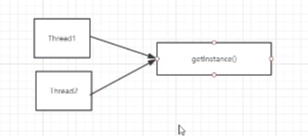立即学习:https://edu.csdn.net/course/play/28941/403575?utm_source=blogtoedu
单例模式(Singleton Pattern)——属于创见型模式。
定义:单例模式是指确保一个类在任何情况下都绝对只有一个实例,并提供一个全局访问点。
隐藏其所有的构造方法。
单例模式的适用场景
确保任何情况下都绝对只有一个实例。(ServletContext、ServletConfig、ApplicationContext、DNPool)
单例模式的常见写法
1.饿汉式单例
2.懒汉式单例
3.注册式单例
4.ThreadLocal单例
饿汉式单例——在单例类首次加载时就创建实例
/**
* 饿汉式单例
* 优点:执行效率高,性能高,没有任何的锁
* 缺点:某些时候可能造成内存浪费;*/
public class HungrySingleton {
private static final HungrySingleton hungrySingleton = new HungrySingleton();
private HungrySingleton(){}
public HungrySingleton getInstance(){
return hungrySingleton;
}
}
// 另一种写法(类的加载顺序,先静态后动态;先上后下;先属性后方法)
public class HungryStaticSingleton {
private static final HungryStaticSingleton hungrySingleyon;
static {
hungrySingleyon = new HungryStaticSingleton();
}
private HungryStaticSingleton(){}
public static HungryStaticSingleton getInstance(){
return hungrySingleyon;
}
}懒汉式单例——被外部类调用时才创建实例

/**
* 懒汉式单例
* 优点:节省了内存;线程安全
* 缺点:性能低
* */
public class LazySimpleSingleton {
private static LazySimpleSingleton instance;
private LazySimpleSingleton(){}
public synchronized static LazySimpleSingleton getInstance(){
if (instance == null){
instance = new LazySimpleSingleton();
}
return instance;
}
}
/**优点:性能高了;线程安全了
缺点:程序可读性差*/
public class LazDoubleCheckSingleton {
private volatile static LazDoubleCheckSingleton instance;
private LazDoubleCheckSingleton(){}
public static LazDoubleCheckSingleton getInstance(){
// 实例为空时阻塞(检查是否要阻塞)
if (instance == null){
synchronized(LazDoubleCheckSingleton.class){
// 双重检查保证线程安全性(检查是否要重新创建实例)
if (instance == null){
instance = new LazDoubleCheckSingleton();
// 这里存在一个指令重排序的问题?
}
}
}
return instance;
}
}